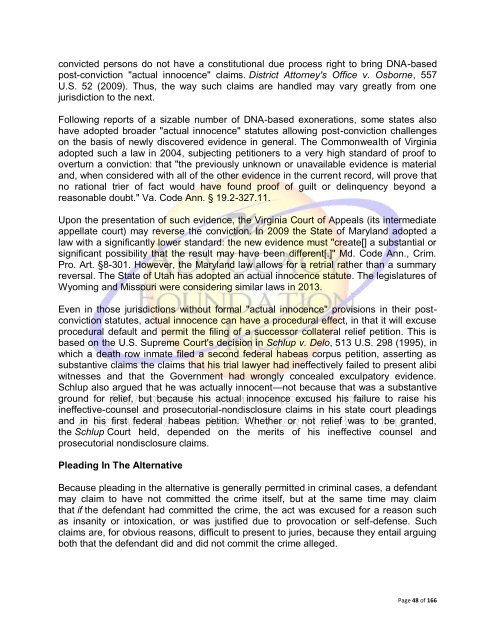You also want an ePaper? Increase the reach of your titles
YUMPU automatically turns print PDFs into web optimized ePapers that Google loves.
convicted persons do not have a constitutional due process right to bring DNA-based<br />
post-conviction "actual innocence" claims. District Attorney's Office v. Osborne, 557<br />
U.S. 52 (2009). Thus, the way such claims are handled may vary greatly from one<br />
jurisdiction to the next.<br />
Following reports of a sizable number of DNA-based exonerations, some states also<br />
have adopted broader "actual innocence" statutes allowing post-conviction challenges<br />
on the basis of newly discovered evidence in general. The Commonwealth of Virginia<br />
adopted such a law in 2004, subjecting petitioners to a very high standard of proof to<br />
overturn a conviction: that "the previously unknown or unavailable evidence is material<br />
and, when considered with all of the other evidence in the current record, will prove that<br />
no rational trier of fact would have found proof of guilt or delinquency beyond a<br />
reasonable doubt." Va. Code Ann. § 19.2-327.11.<br />
Upon the presentation of such evidence, the Virginia Court of Appeals (its intermediate<br />
appellate court) may reverse the conviction. In 2009 the State of Maryland adopted a<br />
law with a significantly lower standard: the new evidence must "create[] a substantial or<br />
significant possibility that the result may have been different[.]" Md. Code Ann., Crim.<br />
Pro. Art. §8-301. However, the Maryland law allows for a retrial rather than a summary<br />
reversal. The State of Utah has adopted an actual innocence statute. The legislatures of<br />
Wyoming and Missouri were considering similar laws in 2013.<br />
Even in those jurisdictions without formal "actual innocence" provisions in their postconviction<br />
statutes, actual innocence can have a procedural effect, in that it will excuse<br />
procedural default and permit the filing of a successor collateral relief petition. This is<br />
based on the U.S. Supreme Court's decision in Schlup v. Delo, 513 U.S. 298 (1995), in<br />
which a death row inmate filed a second federal habeas corpus petition, asserting as<br />
substantive claims the claims that his trial lawyer had ineffectively failed to present alibi<br />
witnesses and that the Government had wrongly concealed exculpatory evidence.<br />
Schlup also argued that he was actually innocent—not because that was a substantive<br />
ground for relief, but because his actual innocence excused his failure to raise his<br />
ineffective-counsel and prosecutorial-nondisclosure claims in his state court pleadings<br />
and in his first federal habeas petition. Whether or not relief was to be granted,<br />
the Schlup Court held, depended on the merits of his ineffective counsel and<br />
prosecutorial nondisclosure claims.<br />
Pleading In The Alternative<br />
Because pleading in the alternative is generally permitted in criminal cases, a defendant<br />
may claim to have not committed the crime itself, but at the same time may claim<br />
that if the defendant had committed the crime, the act was excused for a reason such<br />
as insanity or intoxication, or was justified due to provocation or self-defense. Such<br />
claims are, for obvious reasons, difficult to present to juries, because they entail arguing<br />
both that the defendant did and did not commit the crime alleged.<br />
Page 48 of 166

















